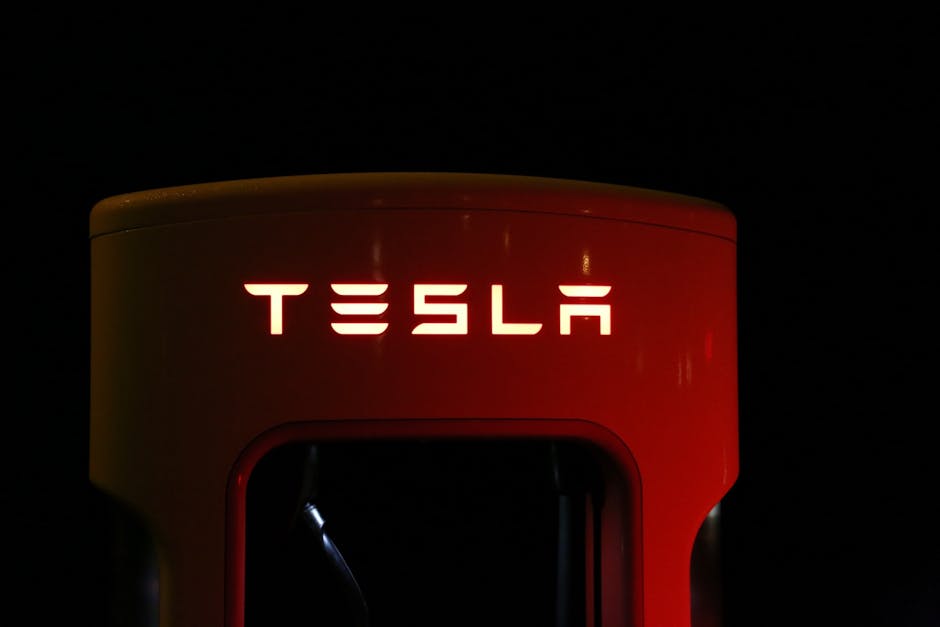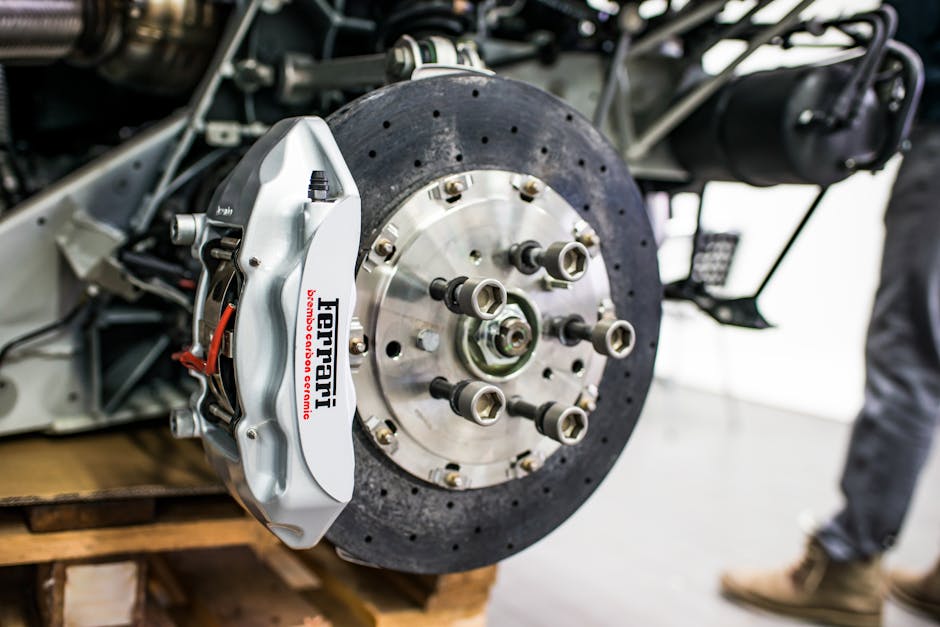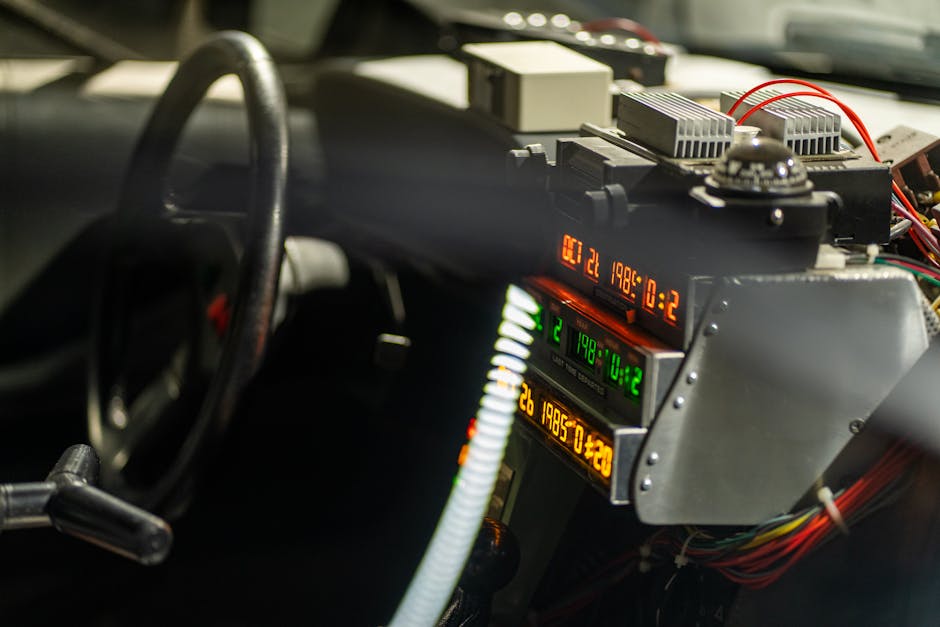Car Tech Updates 2025: 5 Powerful Innovations You’ll Love
The Fast Lane of Car Tech: Latest Innovations Changing Your Drive
Car tech updates are revolutionizing how we drive, making vehicles safer, more efficient, and increasingly autonomous. If you’re looking to catch up on the latest automotive technology trends, here’s what’s making headlines:
| Key Car Tech Updates in 2025 | What It Means For Drivers |
|---|---|
| Adaptive matrix headlights | Better night visibility without blinding others |
| Hood-mounted cyclist airbags | Improved protection for vulnerable road users |
| 912 HP electric powertrains | EVs now outperforming traditional performance cars |
| Four-computer “brain” architecture | Faster processing for safety systems and infotainment |
| Over-the-air software updates | New features without dealership visits |
The automotive landscape is changing faster than ever before. From the 912-horsepower 2025 Audi RS E-Tron GT Performance (the most powerful Audi ever produced) to Subaru’s innovative hood-mounted airbags designed specifically to protect cyclists, manufacturers are pushing boundaries in every direction.
Electrification continues to dominate headlines, with the 2024 Chevrolet Silverado EV becoming the new fast-charge champion among electric trucks. Meanwhile, safety innovations like Virginia’s new law allowing judges to mandate speed limiters for extreme speeders show how technology is being leveraged to protect both drivers and the public.
Inside the cabin, systems are getting smarter too. Tesla’s spring update brings adaptive high-beam headlights to compatible models, while DS has officially integrated ChatGPT as an AI-driven voice assistant. BMW’s four-computer “brain” architecture in its Neue Klasse vehicles promises to transform how cars process information, reducing wiring length by an impressive 2000 feet.
As one automotive engineer noted, “The wiring and computing systems are the last things consumers consider when buying a car—yet they’re becoming the foundation of change.”

Why a List of Car Tech Updates Matters
Staying informed about car tech updates isn’t just about being the tech-savvy person at dinner parties. These innovations directly impact what you’ll drive next, how much you’ll pay, and even how safe you’ll be on the road.
Market trends show that vehicles with the latest technology command higher resale values and experience less depreciation. Consumer insight data reveals that 78% of new car buyers now rank technology features as “very important” in their purchasing decisions—a figure that’s doubled in just five years.
“The gap between early adopters and mainstream consumers has narrowed dramatically,” says a senior automotive analyst. “Features that were once luxury exclusives are now expected as standard equipment within just 2-3 model years.”
1. Electrification Goes Mainstream: Bigger Range, Faster Charging
The electric revolution isn’t just coming—it’s already here, changing how we think about cars in ways that seemed like science fiction just a few years ago.
Remember when EVs were quirky little cars with barely enough range to get you across town? Those days are vanishing in the rearview mirror. The 2025 Mercedes GLC350e plug-in hybrid is a perfect example of how far we’ve come. This sleek SUV lets you handle your daily commute completely on electricity, meaning you might go weeks without using a drop of gas. I recently spoke with a GLC350e owner who told me, “I filled up my tank two months ago, and I’m still driving around with three-quarters of a tank!”
And for the truck lovers who’ve been skeptical about going electric? The 2024 Chevrolet Silverado EV is changing minds with its record-setting fast-charging capabilities. No more waiting hours to juice up—this beast replenishes range faster than any electric truck on the market, making it practical for work and play.

Performance buffs, take note: the 2025 Audi RS E-Tron GT Performance delivers a jaw-dropping 912 horsepower—making it the most powerful Audi ever built. That’s right, the electric future isn’t just green; it’s blindingly fast. These new EVs aren’t just matching traditional performance cars; they’re leaving them in the dust.
Of course, there are challenges. The 2025 BMW M5’s plug-in hybrid system adds a hefty 882 pounds to the vehicle—about the weight of four adult passengers! But manufacturers aren’t sitting idle on this problem, which brings us to some exciting developments in battery tech.
Battery Breakthroughs & Lightweight Materials
The holy grail of EV technology is finally on the horizon: solid-state batteries. Unlike current lithium-ion batteries, solid-state technology promises to be lighter, more energy-dense, faster-charging, and significantly safer (goodbye, fire risk). Several manufacturers have working prototypes, with production models expected within the next few years.
BMW isn’t waiting around. Their upcoming Neue Klasse vehicles will feature sixth-generation battery packs that deliver 30% more driving range and charge 30% faster than current models. That’s not just an incremental improvement—it’s a game-changer for everyday usability.
Meanwhile, Honda is bringing Formula 1 technology to your driveway. Their upcoming 0 Series EVs will incorporate F1-derived lightweight aluminum and composite materials to shed approximately 220 pounds from the vehicle body.
“We’re literally taking what we learned on the racetrack on Sunday and putting it in your garage on Monday,” a Honda engineer told me with a grin. “The same lightweight materials that help F1 cars corner faster are now helping our EVs drive farther on a single charge.”
Charging Infrastructure Fixes
Even the best EV is only as good as the charging network it relies on—and thankfully, this infrastructure is getting much better, very quickly.
Megawatt charging stations are beginning to dot major highways, capable of adding hundreds of miles of range in the time it takes to grab a coffee and use the restroom. For compatible vehicles, a 15-minute stop can now provide enough juice for 3-4 hours of highway driving.
Range anxiety—that nagging fear of being stranded with a dead battery—is being tackled with smarter technology. The latest EVs feature predictive range systems that consider everything from the upcoming terrain to the current weather when calculating remaining range. No more guessing games or white-knuckle drives to the next charger.
Perhaps most exciting is the rise of Vehicle-to-Grid (V2G) technology. Your car will soon be able to power your home during outages or sell electricity back to the grid during peak demand. Imagine earning money from your parked car instead of watching it depreciate in the driveway!
Seven major automakers recently formed Ionna, a joint venture focused on creating a more reliable charging network. Their promise? “A better EV charging experience” with stations that actually work when you need them to. As anyone who’s pulled up to a broken charger knows, reliability matters more than quantity.
Want to learn more about the electric revolution? Check out our in-depth coverage of Electric Vehicles and Automotive Sustainability Initiatives for the complete picture of how car tech updates are electrifying our driving future.
2. Autonomous & Semi-Autonomous Driving: The Road to Robotaxis
Autonomous driving technology is racing forward at breakneck speed, though the finish line of full self-driving remains somewhere over the horizon as regulators and engineers steer the complex road ahead.
Tesla’s recent speed bump highlights just how challenging this journey can be. A court ruling now requires the company to either retrofit computers or compensate owners of roughly 4 million vehicles that weren’t quite as “Full Self-Driving ready” as promised. It’s a stark reminder that sometimes the marketing department moves faster than the engineering team when it comes to car tech updates.

BMW’s Personal Pilot system, meanwhile, is showing us what’s possible today. During real-world testing, this impressive system confidently manages lane changes and steers tricky traffic patterns while keeping drivers engaged. The system blends lidar-fusion technology with advanced sensor redundancy to create a safety net that feels reassuringly comprehensive.
On the regulatory front, Virginia has boldly gone where no state has gone before, enacting a law that allows judges to mandate speed limiters for drivers caught at extreme speeds over 100 mph. It’s a fascinating example of how technology can be leveraged to protect both lead-footed drivers and everyone sharing the road with them.
Car Tech Updates in Autonomy
The autonomous driving journey continues its steady climb from Level 2 (partial automation) toward Level 4 (high automation). Most vehicles on the road today operate in the Level 2-3 range – capable of handling many driving tasks but still requiring an alert human ready to take over.
Over-the-air updates have transformed how we receive car tech updates for autonomous features. Remember when getting new features meant visiting a dealership? Those days are fading fast. Now your car can literally learn new driving tricks while parked in your garage overnight, with many manufacturers adopting subscription models that let you activate advanced features as needed.
The regulatory landscape is evolving too, with the National Transportation Safety Board suggesting that the federal government should require or incentivize speed limiters on all U.S. vehicles. As one safety advocate put it: “The technology exists today to prevent many speed-related crashes. What’s needed now is the regulatory will to implement these systems more broadly.”
For those interested in diving deeper into this fascinating technology revolution, our Advanced Car Technology section offers comprehensive coverage of the latest developments.
Cybersecurity & Data Privacy
As our cars get smarter, they also become more vulnerable to a threat our grandparents’ vehicles never faced: hacking. Thankfully, manufacturers are taking this seriously.
Encrypted bus systems have become standard in new vehicle architectures, protecting critical communications from digital intruders. Tesla’s shift from traditional CANBUS to a more secure TDMA-based network shows how seriously manufacturers are taking these threats.
Firewall gateways now create digital barriers between your car’s critical systems and the infotainment networks. This smart approach means that even if someone manages to hack your streaming music service, they can’t access your braking system. It’s similar to how banks protect their most sensitive systems with multiple security layers.

BMW’s innovative four-computer “brain” architecture in their Neue Klasse vehicles includes dedicated security processors that stand guard 24/7, constantly monitoring for unauthorized access attempts. It’s like having a digital security team permanently assigned to your vehicle.
These cybersecurity measures might not be as exciting as horsepower numbers or acceleration times, but they’re becoming increasingly important as our vehicles transform into computers on wheels. After all, what good is a smart car if it’s vulnerable to smart hackers?
3. Safety Innovations Beyond the Cabin
Safety technology is extending beyond protecting vehicle occupants to safeguarding vulnerable road users like pedestrians and cyclists.
Subaru’s innovative hood-mounted airbag for the new Forester represents a significant advancement in cyclist protection. This system extends all the way to the top of the A-pillars, providing crucial protection for cyclists who, when standing on their pedals for maximum speed, would otherwise impact the upper A-pillar without this extended coverage.
Adaptive matrix headlights are finally coming to U.S. and Canadian Tesla vehicles built from 2022 onward with factory-installed matrix headlights. These sophisticated lighting systems can dim individual pixels to avoid blinding other road users while maintaining bright illumination elsewhere, dramatically improving nighttime visibility and safety.
Tesla has also resolved TPMS (Tire Pressure Monitoring System) errors with its 2024.44.x software update, demonstrating how even basic safety systems are benefiting from over-the-air update capabilities.
| Feature | Hood-Mounted Airbag | Traditional Pedestrian Airbag |
|---|---|---|
| Coverage Area | Hood to top of A-pillars | Lower windshield and hood only |
| Protection for Standing Cyclists | Yes | Limited |
| Deployment Speed | Under 30ms | Under 30ms |
| Impact on Vehicle Design | Requires specific hood geometry | Minimal design impact |
| Availability | 2025 Subaru Forester (Japan) | Various European models |
Vision-Based Lighting Upgrades
Matrix-beam technology represents a significant advancement in vehicle lighting. Unlike traditional headlights that simply switch between high and low beams, matrix systems use multiple LED elements that can be individually controlled.
“These systems can create a corridor of darkness around oncoming vehicles while keeping the rest of the road brightly illuminated,” explains a lighting engineer. “It’s like having high beams on all the time without blinding other drivers.”
Glare control is another benefit of these advanced lighting systems. By precisely controlling the direction and intensity of light, matrix headlights reduce eye strain and fatigue for both the driver and other road users, contributing to overall road safety.
Tesla’s spring 2024 update enables these features on compatible models, demonstrating how software can open up hardware capabilities that were previously dormant due to regulatory limitations.
External Protection Systems
Hood-bags and A-pillar cushioning systems represent a new frontier in vehicle safety, extending protection beyond the cabin to vulnerable road users.
Subaru’s approach with hood-mounted airbags that extend to the A-pillars addresses a critical safety gap for cyclists. When cyclists stand on their pedals, their heads are positioned higher than traditional pedestrian airbags can protect, making this extended coverage particularly valuable.
Some safety experts have suggested that covering the windshield with external airbags could provide additional protection and potentially reduce hit-and-run incidents by forcing drivers to stop and exchange insurance information after a collision.
As one safety advocate noted, “A 4-inch taller hood can make a vehicle 22% more likely to kill a pedestrian upon impact.” This statistic highlights why these external protection systems are becoming increasingly important as vehicles continue to grow larger and heavier.
4. Connected Cockpits & Infotainment Upgrades
The in-car experience is undergoing a remarkable change, with cutting-edge infotainment systems, intelligent AI assistants, and mind-bending mixed-reality displays that make yesterday’s tech feel like ancient history.
Apple’s next-generation CarPlay is set to completely reimagine how we interact with our vehicles, fully integrating into dashboards wherever automakers permit. This isn’t just a minor update—it’s a comprehensive takeover of your vehicle’s digital real estate. Luxury brands like Aston Martin and Porsche have already unveiled their stylish interpretations of this deeper integration.
Volkswagen is making amends for past tech missteps with their rebooted MIB4 driver interface. After years of complaints about laggy screens and confusing menus, early tests suggest VW has finally cracked the code with a cleaner, quicker, and altogether smarter experience that might just win back frustrated owners.

Tesla continues to prove that the car you drive home keeps getting better with age. Their spring OTA (Over-The-Air) update brought several welcome improvements—from adaptive high-beam headlights to blind spot camera improvements and even personalized trunk opening heights. All without a single visit to the dealership!
“My Tesla literally gets better while I sleep,” one owner told us. “I wake up to new features I didn’t have when I parked it the night before. It’s like Christmas morning, but for car nerds.”
ChatGPT assistants are no longer science fiction—they’re riding shotgun in production vehicles. DS has officially acceptd the AI revolution after successful UK trials, integrating a system that not only understands complex questions but actually learns from your interactions. Forget robotic voice commands; these assistants can handle nuanced conversations that feel surprisingly human.
Mixed-reality HUDs (Head-Up Displays) have evolved far beyond simple speedometer projections. The latest systems overlay rich information directly onto your view of the road ahead—highlighting potential hazards, suggesting optimal driving lines, and providing context about your surroundings. It’s like having a co-pilot who can see things you might miss.
AI Assistants & Over-the-Air Car Tech Updates
Voice-activated AI assistants have become dramatically more capable and natural. Tesla has even launched a specialized AI agent designed specifically to improve service communications—proactively addressing issues and handling customer concerns with unprecedented efficiency.
The way we access vehicle features is changing too. Rather than paying upfront for every conceivable bell and whistle, feature subscriptions now let drivers activate specific capabilities only when needed. Heading to the mountains for a ski weekend? Activate your advanced snow mode for just those few days instead of paying for it year-round.
Car tech updates analytics have become a goldmine for manufacturers, providing detailed insights into which features owners actually use. This wealth of real-world data helps companies focus development resources where they’ll make the biggest difference—accelerating innovation across the industry.
“The vehicle is becoming a software platform first and a transportation device second,” explains a technology analyst I spoke with recently. “This fundamental shift creates a completely different relationship between carmakers and drivers—one where your vehicle continues improving throughout its life.”
Mixed Reality Drives & VR Track Guides
BMW’s M Mixed Reality system offers perhaps the most ambitious blend of virtual and physical driving experiences. Imagine piloting a real BMW M4 while simultaneously experiencing a virtual track environment—feeling every actual bump and g-force while visual elements are overlaid through special goggles. It’s part training tool, part video game, and entirely revolutionary.
Cupra’s Exponential Experience takes a similar approach with their VR driving experience. While currently limited to controlled environments, these technologies hint at a future where the line between digital and physical driving experiences becomes wonderfully blurred.
“These mixed reality systems are changing how we think about driver training,” a driving instructor explained. “They let you practice techniques in complete safety before applying them in situations where mistakes might be costly.”
For track enthusiasts, augmented reality guides can now project the ideal racing line directly in your field of view, helping improve lap times and driving technique. It’s like having a professional coach riding along, showing exactly where to brake, turn, and accelerate for the perfect lap—technology that was once exclusive to professional racing simulators is now finding its way into production vehicles.
Visit our Luxury Car Technology and Automotive Connectivity Solutions pages to learn more about these exciting developments.
5. Motorsport Tech Trickling Down to Road Cars
Racing has always been a laboratory for automotive innovation, but the pace at which car tech updates move from track to street has never been faster. What once took decades now happens in just a few model years – and it’s changing our everyday vehicles.
BMW’s Neue Klasse vehicles showcase this perfectly with their four computer “brains” architecture. This racing-inspired design doesn’t just improve performance – it actually reduces total wire length by an impressive 2,000 feet! For drivers, this means more responsive systems, better reliability, and vehicles that are literally lighter on their feet.
The shift to 48-volt Low Voltage Control Systems (LVCS) is another racing innovation making mainstream waves. These higher-voltage systems deliver more electrical punch while actually reducing wiring size and weight – a win-win that began in motorsport’s relentless pursuit of efficiency.

Remember when race telemetry was something you’d only see in F1 broadcasts? Those sophisticated data systems are now finding their way into production cars, giving everyday drivers insights into vehicle performance that were once reserved for professional racing teams. Imagine knowing exactly how your cornering technique affects tire wear or how your acceleration habits impact fuel economy – that’s the power of racing telemetry coming to your driveway.
Weight reduction through carbon fiber components continues to filter down from racing as well. Ford’s announcement that its motorsport experience is directly influencing a planned “off-road supercar” shows just how strong this connection remains. As one engineer put it, “The racetrack is still our most demanding proving ground – if it works there under extreme conditions, we know it’ll work on the road.”
Wiring & Network Revolutions
The humble wiring harness might not seem exciting, but Tesla’s switch from traditional CANBUS to a more sophisticated TDMA (Time Division Multiple Access) bus architecture represents a quantum leap in vehicle networking.
“CANBUS is like everyone shouting in a crowded room hoping to be heard,” explains an automotive network engineer with a smile. “TDMA is more like scheduled one-on-one meetings. The difference in reliability is dramatic.”
This approach assigns specific time slots through a dynamic Network Allocation Map, guaranteeing delivery of critical signals – think of it as giving emergency vehicles a dedicated lane through traffic. For drivers, this translates to more responsive controls and systems that simply work when you need them.
The days of hunting for blown fuses with a flashlight may soon be over thanks to smart fuses replacing traditional mechanical ones. These electronic components can be monitored remotely, allowing for diagnostics without ever opening a panel. Even better, they can often prevent failures before they happen by detecting unusual patterns and alerting drivers or technicians.
Perhaps most impressively, the LVCS system has managed to reduce connector types from over 200 down to just six standardized options. This might sound like a small detail, but it’s for manufacturing efficiency and repair simplicity. Imagine if your home suddenly had just one type of electrical outlet instead of dozens – that’s the scale of simplification happening under the hood.

The beauty of these motorsport-derived innovations is that they improve vehicles in ways most of us never see but definitely feel. They make our cars lighter, more reliable, and more capable – all while reducing complexity and ultimately cost. The race-inspired technology revolution happening beneath the surface is just as important as the flashy new features that grab headlines.
As you explore more about how racing influences your daily drive, our Race Car Telemetry Systems guide offers a deeper dive into how data collection is changing both motorsport and mainstream vehicles.
Frequently Asked Questions about Car Tech Updates
What are the most impactful car tech updates consumers will see in 2025?
If you’re wondering which innovations will actually change your driving experience in 2025, you’re not alone! The automotive landscape is evolving rapidly, and several car tech updates stand out from the crowd.
The electric revolution is picking up serious speed, with vehicles like the 2025 Audi RS E-Tron GT Performance packing a jaw-dropping 912 horsepower. Remember when electric cars were considered slow? Those days are firmly in the rearview mirror! Meanwhile, the Chevrolet Silverado EV is tackling range anxiety head-on with industry-leading fast-charging capabilities that make road trips genuinely practical.
Behind the wheel, semi-autonomous driving is becoming more refined and trustworthy. BMW’s Personal Pilot system feels less like a gimmick and more like a genuinely helpful co-pilot during those tedious commutes. It’s not about replacing drivers—it’s about making driving less stressful when you need a break.
Perhaps most heartening is seeing safety innovations extend beyond protecting just vehicle occupants. Subaru’s thoughtfully designed hood-mounted airbags specifically protect cyclists, showing how car safety is evolving to protect everyone on our roads.
The ability to improve your car without visiting a dealership is another game-changer. Over-the-air updates mean your vehicle actually gets better over time—something that would have seemed like science fiction just a decade ago.
And let’s not forget how AI is making cars smarter everyday companions. From ChatGPT voice assistants that actually understand natural language to proactive service agents that alert you to potential issues before they become problems, our vehicles are becoming increasingly intuitive partners in our daily lives.
How are manufacturers fixing EV-charging and range challenges?
The early days of EVs often meant anxiety about finding chargers and worrying about making it to your destination. Thankfully, manufacturers are tackling these pain points from multiple angles.
Battery technology is making remarkable leaps forward. BMW’s sixth-generation battery packs aren’t just marginally better—they’re promising 30% more range and 30% faster charging. These aren’t incremental improvements; they’re transformative advances that make electric vehicles practical for more drivers in more situations.
The charging experience itself is getting much-needed attention through collaborative efforts like Ionna, where seven major automakers are pooling resources to create charging stations that actually work reliably. The days of showing up to a non-functional charger are (hopefully) coming to an end.
One of the cleverer innovations is more intelligent range prediction. Rather than giving you an overly optimistic number that plummets as soon as you hit the highway, newer systems consider everything from the elevation changes on your route to the outside temperature, giving you realistic expectations about when you’ll need to plug in.
Vehicle-to-grid integration is opening fascinating possibilities too. Imagine your car not just consuming electricity but also feeding it back to your home during a power outage or selling it back to the grid during peak demand periods. This two-way relationship with energy makes EVs more than just transportation—they become part of your home energy ecosystem.
Weight reduction efforts, like Honda’s Formula 1-inspired approach to cutting 220 pounds from their EV bodies, show how motorsport continues to influence everyday driving. Less weight means more range without bigger batteries—a win-win for efficiency and driving dynamics.
Are new autonomous features safe and legally approved?
The question of autonomous driving safety isn’t as simple as a yes or no answer—it exists in shades of gray that vary by location, technology, and implementation.
Most jurisdictions today permit Level 2 systems, which assist drivers but require constant supervision. The legal framework gets considerably more complex for higher levels of autonomy, with regulations evolving at different paces across states and countries. This patchwork approach creates challenges for both manufacturers and consumers trying to understand what’s allowed where they drive.
Behind the scenes, the testing process for these systems is extraordinarily rigorous. Manufacturers are logging millions of miles in both real-world conditions and sophisticated simulations, identifying edge cases and potential failures before systems reach consumers.
Recent legal precedents, like the Tesla computer retrofit ruling that required the company to address hardware inadequacies for promised Full Self-Driving capabilities, are establishing important guardrails around how these technologies are marketed and delivered.
While comprehensive safety data is still emerging, preliminary statistics suggest properly used driver assistance systems can indeed reduce accident rates. The key phrase here is “properly used”—these systems work best when drivers understand their capabilities and limitations.
That’s why consumer education has become such a focus for responsible manufacturers. The most sophisticated technology in the world can’t compensate for misunderstanding how it works. Clear communication about what these systems can and cannot do is essential for safety.
Despite marketing terminology that sometimes suggests otherwise, it’s crucial to understand that no currently available consumer vehicle is fully autonomous. Every system on the market today, including those with ambitious names like “Full Self-Driving,” requires an attentive driver ready to take control at a moment’s notice. The truly driverless future may be coming, but it’s not quite here yet.
Conclusion
The automotive world is changing faster than a Formula 1 pit stop, with car tech updates changing every aspect of our driving lives. From the garage to the highway, today’s vehicles are evolving into something our grandparents wouldn’t recognize.
Jaw-dropping 912-horsepower Audi RS E-Tron GT Performance we mentioned? Or the Chevrolet Silverado EV that’s redefining what “fast charging” means for trucks? These aren’t just incremental improvements—they’re leaps that show how quickly electric vehicles are becoming the new normal for performance and practicality.
Under the hood (or where the hood used to be), BMW’s sophisticated four-computer “brain” architecture and Tesla’s TDMA-based network are completely reimagining the nervous system of our vehicles. These aren’t the kinds of updates you’ll immediately notice during a test drive, but they’re creating the foundation for everything else that makes modern cars feel magical.
I’m particularly excited about safety innovations expanding beyond just protecting us inside the cabin. Subaru’s thoughtful hood-mounted airbags for cyclists and those adaptive matrix headlights that can illuminate exactly what you need to see without blinding others show how technology is making roads safer for everyone.
Inside the cockpit, AI assistants that actually understand what you’re asking and mixed-reality displays are creating experiences that feel more like partnerships between car and driver rather than just transportation. The future of driving isn’t just about getting from A to B—it’s about enjoying every moment of the journey.
What’s fascinating is how quickly racing innovations now reach our driveways. Formula 1-derived materials and engineering techniques that once took a decade to trickle down to production cars are now making the leap in just a couple of years.
At Car News 4 You, we’re passionate about keeping you in the driver’s seat of all these changes. Our unique perspective on the intersection of car culture and innovation helps you understand not just what’s changing, but why it matters to your driving life.
The road ahead is clear: our vehicles are becoming smarter, safer, more efficient, and more connected with each passing year. Whether you’re a tech enthusiast who loves being on the cutting edge or simply someone who wants to make an informed choice about your next vehicle purchase, understanding these trends gives you the advantage.
Explore more auto-tech trends with us at Car News 4 You, where we break down the complicated world of automotive innovation into insights you can actually use and enjoy.








3 thoughts on “From Self-Driving to Motorsport Marvels, Catch Up on Car Tech Updates”
Pingback: Connected Cars Unplugged: Key Trends You Can’t Ignore - Car News 4 You
Pingback: Smooth Rides Ahead: Top Cars for Long Commutes and Highway Driving - Car News 4 You
Pingback: Luxury Goes Green: Eco-Friendly Cars for the Modern Driver - Car News 4 You
Comments are closed.